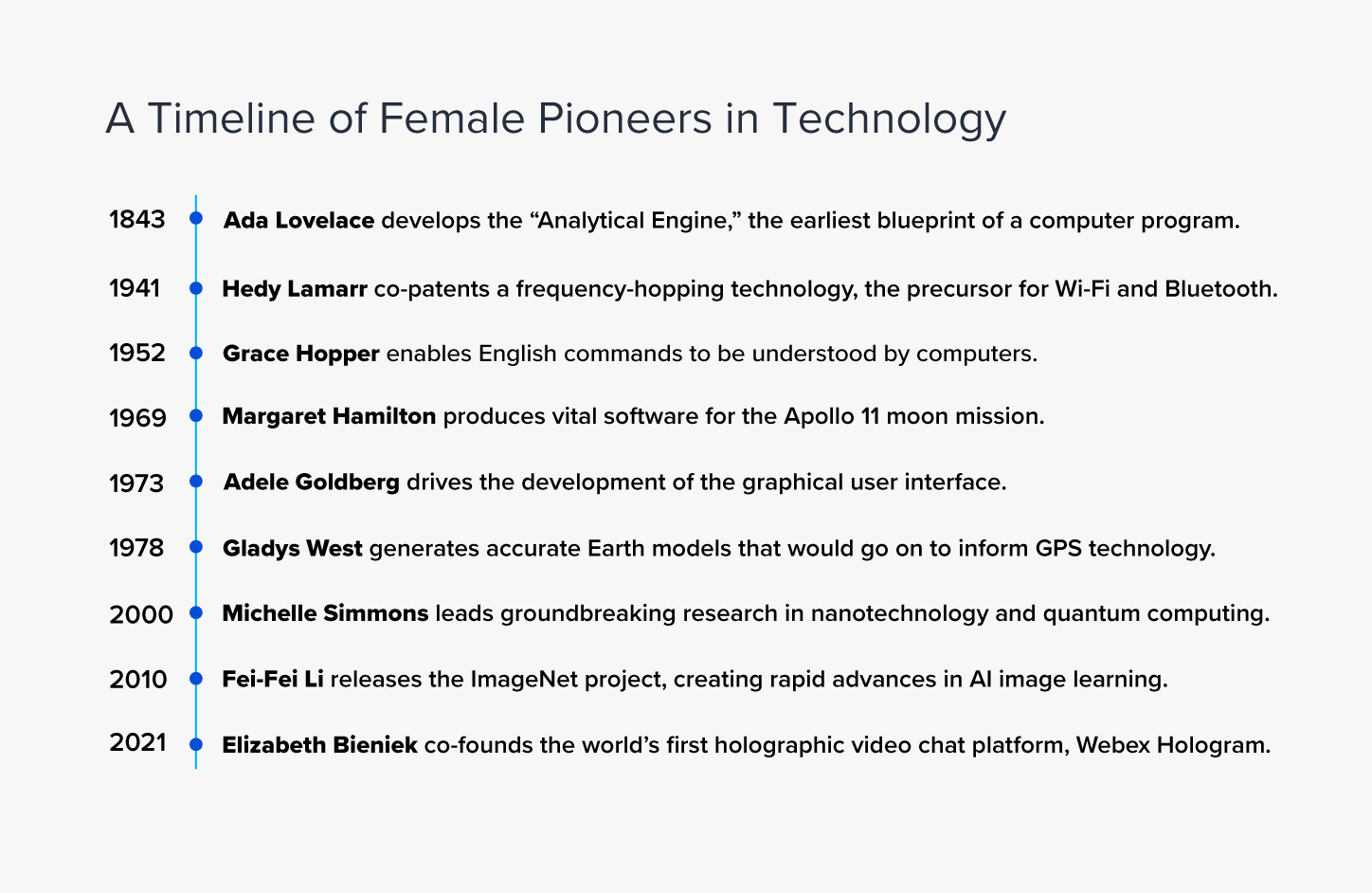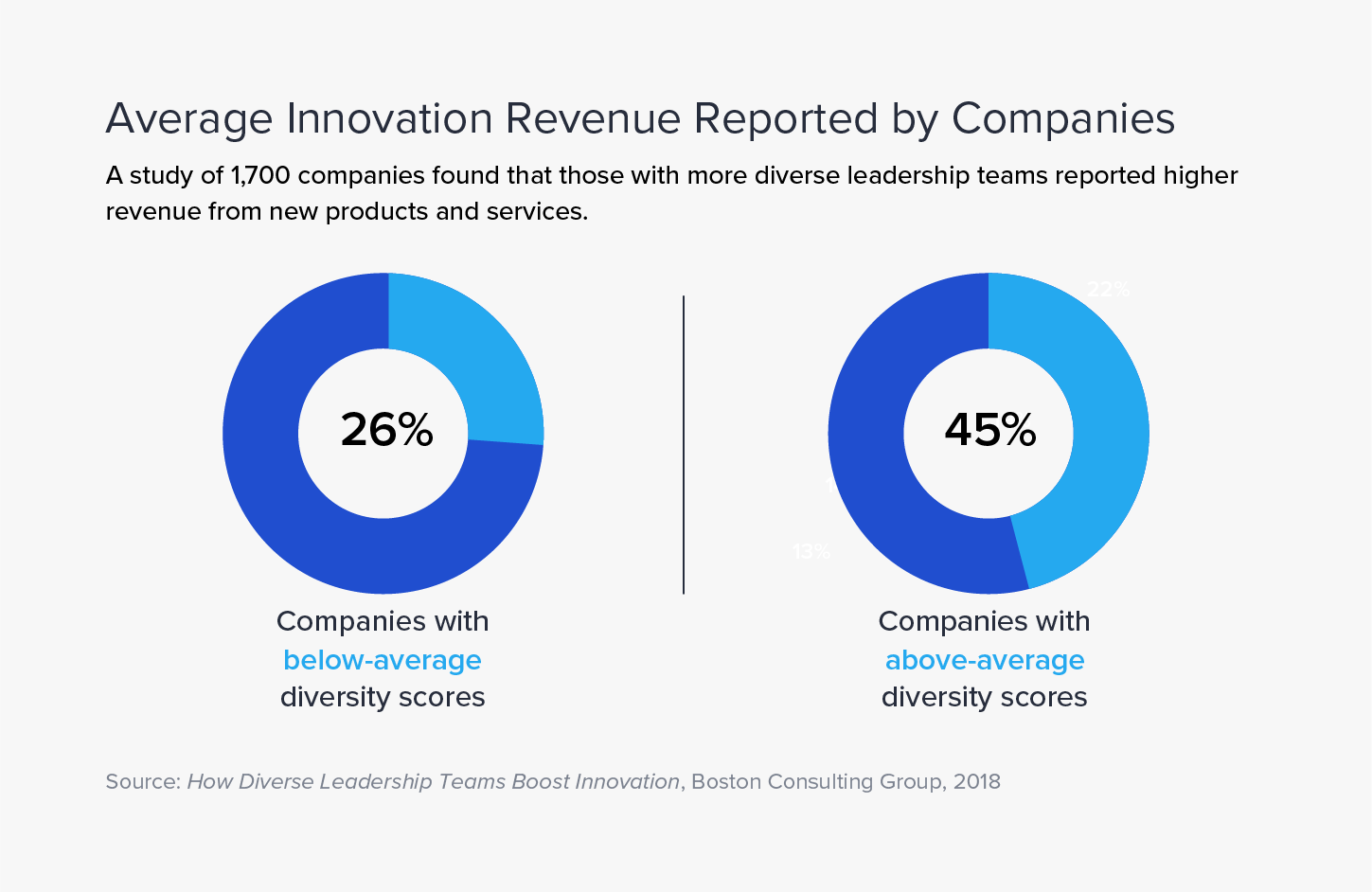Why You Should Hire a Woman for Your Next Open Tech Role
authors are vetted experts in their fields and write on topics in which they are extremely knowledgeable. All of our content is peer reviewed and validated by world-class professionals.

Featured Experts
Women have always played key roles in moving technology forward. The first computer program was written by Ada Lovelace for the “Analytical Engine,” a computational machine invented in the mid-19th century. In the 1940s, actress Hedy Lamarr co-patented a frequency-hopping technology that became the precursor to Bluetooth and Wi-Fi. Fast-forward to 2021 when Cisco intrapreneur Elizabeth Bieniek co-founds Webex Hologram, the world’s first holographic videoconferencing platform.
Despite their significant contributions, however, women represent only a quarter of full-time tech employees in the US. But there is forward motion toward increased gender parity and inclusion in the industry: Female representation overall inched up almost 7% between 2019 and 2022, according to the most recent report by Deloitte Global. Women in technical roles, specifically, increased by nearly 12%.

Staffing.com spoke with experts from Intel, IBM, Xerox, and Koch Industries to find out why women are key players in tech and how your company can attract them for open roles.
Gender Diversity Is Linked to Increased Innovation
Concerns about fairness and inclusivity aren’t the only—or even the primary—reason organizations are seeking out and recruiting women for technology jobs. A 2019 study by McKinsey & Company found that organizations that have women in more than 30% of executive roles performed better financially than those with a lower percentage of female leaders. Companies with women in just 10% to 30% of leadership roles outperformed organizations with fewer women executives.
This is also true of innovation. A seminal 2018 Boston Consulting Group study of 1,700 companies across eight countries looked at the relationship between innovation and the diversity—including gender, age, and national origin—of management teams. Organizations with above-average diversity earned significantly more innovation revenue—profit generated by new products and services—than those with below-average diversity: 45% and 26%, respectively.

Women Score High in Problem-solving and Change-making
Recent research by the leadership consultancy Zenger Folkman analyzed more than 7,000 360-degree reviews of male and female leaders and found that women scored highly in several key leadership competencies, including solving problems, taking initiative, and driving change.
These findings are supported by interviews with the experts Staffing.com consulted. For example, Jenny Strange, Senior Director for Business Transformation Design at Koch Industries, says she has seen appreciable growth in female representation in work that involves intuition and predictive analysis. “There’s a role in many of our big system implementations called Solution Architect, and it’s a role that helps connect all the processes and technology. It’s the integration of everything end to end. I’ve seen a lot more females playing that role, and they’ve been really successful there.”
Strange has also noted an increasing number of women driving change on product teams and playing major roles in leading the digital transformation of finance and accounting systems. Data on the national workforce in tech supports her observation: Jobs that require interpretive and anticipatory thinking appear to be the areas women are pursuing and advancing in proportion to the industry. In 2021, data from the US Bureau of Labor Statistics showed that women currently make up 51% of web and digital interface designers; 47% of software quality assurance analysts and testers; 39% of web developers; and 38% of computer systems analysts.
How to Recruit and Retain Women in Tech Roles
As any HR leader knows, attracting skilled women for open technology roles isn’t as simple as placing a job listing on your company’s career page. Fighting stereotypes and increasing gender parity requires goal-setting, strategy, and concerted efforts, say the experts we interviewed. Intel set a goal to increase the presence of women in technical roles to 40%, for example, and has made specific changes to its HR processes and culture to get there. “I would challenge the HR leadership of companies around the world to say, ‘If we just keep doing the same thing, we just won’t make progress at the rate that we need to make it,’” Christy Pambianchi, Executive Vice President and Chief People Officer at Intel, tells Staffing.com. What follows are three simple but useful steps that could increase the number of women in your hiring pipeline and retain them once they’re hired.
Adjust Your Job Postings
Some older research has suggested that women don’t apply to jobs unless they’re certain they meet most, if not all, of the listed requirements, while men will apply if they meet about 60% of them. The validity of that specific statistic has since come into question, but recent research by LinkedIn supports the underlying gist: Women do appear to be more selective than men when applying for jobs. They are 16% less likely than men to apply for any particular job after viewing the listing, and they apply to 20% fewer jobs than men do.
Women’s leadership expert Tara Mohr—who has consulted for Nike, Intuit, and Starbucks—had surveyed more than 1,000 people about why they haven’t applied to jobs for which they didn’t meet 100% of the qualifications. The primary reason women didn’t apply? They didn’t think a recruiter or hiring manager would give them the time of day and didn’t want to waste their own time and energy.
The upshot: If you write more inclusive job ads and descriptions, more women will apply to your jobs—tech or otherwise. To do that:
- Focus on performance objectives more than requirements.
- Remove “nice-to-have” qualifications and spend more time addressing the goals and objectives the new hire will be expected to meet.
- Make sure you’re using gender-neutral language.
- Add benefits information, since it’s often a key thing female candidates look for, LinkedIn researchers suggest.
Use AI to Reduce Bias
Organizations like Xerox are using AI to avoid bias in their recruiting and hiring practices—removing bias from job descriptions and enabling impartial decision-making during the interview process, for example. According to Aptitude Research, “77% of companies are interested in using or currently using AI to support sourcing efforts.”
It’s important, however, that organizations don’t rely on AI alone to guide their recruitment efforts. “While we use AI to help increase our sourcing of women and diverse talent, it’s important to acknowledge that it does bring challenges,” Suzan Morno-Wade, CHRO at Xerox, tells Staffing.com. “What we’ve seen is AI cannot operate on its own. This is the marrying of human judgment and influence with AI.”
Boost Female Representation in Leadership Roles
Nearly two-thirds of women in tech see no clear path to advancement within their current organizations, according to the 2021 Women in Tech Report by TrustRadius. Other research explains why: Women in technical roles really are less likely than men to be promoted early in their careers, a 2022 McKinsey analysis found. Perhaps unsurprisingly, many women leave the field. Researchers at McKinsey offer a few strategies for retention, including implementing well-defined criteria for early promotions to avoid unintended bias, and matching early-tenure women with sponsors and mentors.
Mentorship, coaching, and career roadmapping are tentpoles of the IBM Pathways to Technical Leadership Program, IBM’s Kitty Chaney Reed tells Staffing.com. The program pairs female technology employees with a coach and sponsor, and includes a two-day workshop to discuss employees’ needs and skills, and create an advancement plan.
“Post-workshop, the participant, manager, coach, and sponsor meet regularly and use the career advancement plan to close experience gaps, identify opportunities, and expand the participant’s network,” she says. “The coach and sponsor are committed to supporting and engaging with their participants until they achieve their desired senior technical leadership role.”
Support a Flexible Workforce Culture
Although some high-profile executives have begun to sour on remote and hybrid work, research shows that a flexible work culture is still vital in attracting and retaining female employees. In a 2022 Pew Research Center survey, 51% of women said they’re more productive when allowed to work from home, compared to just 37% of men. A 2022 YouGov study found that 44% of women say the ability to work from anywhere is very important when choosing an employer versus 33% of men.
Such flexibility is often most important to women in the workplace, since child care and other home responsibilities still fall more heavily on female shoulders. Owing to this, when companies enforce strict return-to-office policies, the effects may be felt more acutely by female workers. “I think it’s very shortsighted of employers to think that people have to work one single way,” Cynthia Cherry, CHRO at MarketWise, tells Staffing.com. “Maybe there’s a business reason or a business case for having certain limitations, of course—but when and where you can, look for ways to give that latitude to people. That pays dividends in the long run.”
The gender divide in the tech industry is shrinking, but organizations must take an active role in recruiting and retaining women if we are to see substantial progress. Women have a lot to offer, and there are huge commercial benefits to be reaped from more balanced representation. One thing is clear: The power of contributions from women in tech is far stronger than the outmoded obstacles that they continue to face.
Interviews and additional reporting by Peter Matuszak and Kristen Senz.





